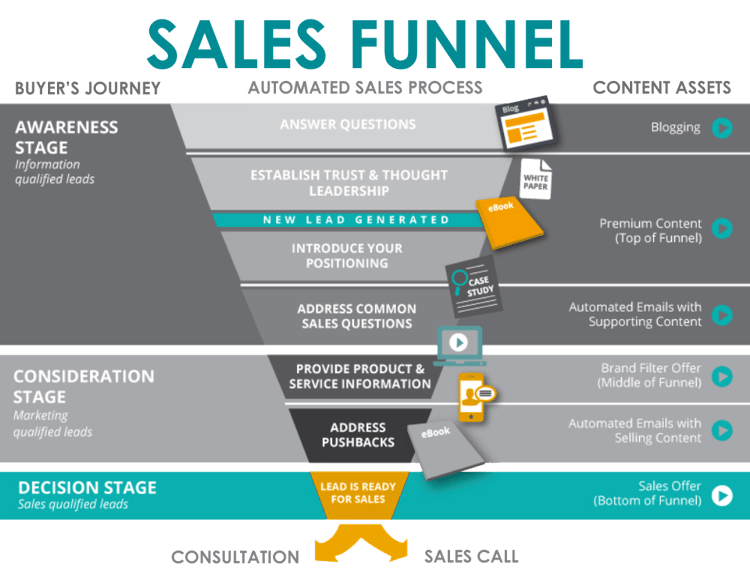Myth: Content Marketing Is Only for B2C Brands, Not Manufacturers
Sure, inbound marketing can be great for B2C companies. Creating interesting content for those companies is a great way to increase leads with...
4 min read
 Benjamin Engel
Feb 23, 2017
Benjamin Engel
Feb 23, 2017

As a business leader for a B2B company, you have responsibilities company-wide: caring for your employees, making sure customers are happy, ensuring that sales are up and losses are down, and possibly most importantly, working toward a high return on all investments. In your budget, marketing most likely has one of the highest-cost line items - but it should also have one of the highest returns. Contrary to popular belief, you can have faith in your marketing department's ability to produce high, measurable returns on your investments through a successful marketing strategy.
But how do you know if it’s working?
Simply put, your B2B marketing strategy is “working” when it’s meeting your marketing and business goals.
You should absolutely be able to identify the returns from your B2B business's marketing strategy accurately and with great reliability. Here are some questions to ask your team to help determine if your current marketing strategy is working, or if it’s time to pursue a new one with your team.
 The answer you’re looking for here is “to gain qualified leads for our sales team” or, potentially, “to increase our current customer base.” After all, that's the goal of 74% of today's marketing and sales teams, according to HubSpot's State of Inbound 2016. Obviously, this will depend on your own business goals, but when it comes to an inbound aligned sales and marketing approach, your marketing team should be pursuing these measurable goals.
The answer you’re looking for here is “to gain qualified leads for our sales team” or, potentially, “to increase our current customer base.” After all, that's the goal of 74% of today's marketing and sales teams, according to HubSpot's State of Inbound 2016. Obviously, this will depend on your own business goals, but when it comes to an inbound aligned sales and marketing approach, your marketing team should be pursuing these measurable goals.
This includes anything from print ads, to billboards, to direct mail, and everything in between. Depending on the answer to question 1, this calculation will vary from number of qualified leads gained to sales closed. However you’re measuring success from marketing, stay consistent across the board. Keep in mind that traditional marketing tactics have been very difficult to measure with accuracy; for more information on how you can turn these tactics around to become more inbound-oriented and measurable, read our Guide to B2B Inbound Marketing.
In the past, marketing hasn’t been able to very accurately draw a line between marketing spend and return on investment. However, with the advent of digital, all bets are off. There should be a clearly defined measurement of digital leads and the return from those dollars when it comes to advertising and digital marketing dollars.
SEO - search engine optimization - is a must-have for any B2B business to succeed today. Successful SEO centers around targeting a defined set of long-tail keywords using correctly set-up website pages, consistently updated and fresh content (such as a blog), and setting up your website to be optimized for search engines to easily crawl your site and find what users - searchers - are looking for on sites like Google, Yahoo, and Bing.
Successful SEO efforts will include updated measurements of keyword strength, domain authority, crawl reports, error reports, and more on a monthly basis. SEO is a slow-moving metric, but very important for online success.
If your marketing team isn’t currently doing any content marketing (and by that I mean blogging, producing downloadable pieces, and educating through written and video content on your site), it’s time to get on board the content marketing train, right now. If your team is already doing so, I’m glad to hear it; many B2B companies still aren’t employing this invaluable tactic for bringing in marketing qualified leads.
The current campaign for content marketing should be focused around a few key elements:
Conversion rate can be measured in one of two ways - converted visitors to contacts, or converted contacts to sales. Typically in B2B inbound marketing with a growth-driven focus, the first is considered the most important metric. Since converting a contact to a sale resides firmly in the hands of the sales team, that’s part of the sales strategy goals.
A buyer’s journey illustrates the path you’d like your ideal customer to walk through via your website or other marketing efforts. Often it’s shown as a funnel, with three stages:

Your marketing team should be able to identify these stages and draw a logical path for the potential buyer to follow upon visiting your website. Your site should have content targeting each stage of the journey that your buyer should go through. This process is closely tied to advanced tactics practiced by inbound B2B companies.
Growing B2B companies are focused on increasing the number of leads and the percentage of closed-won leads coming through their site. To stand apart from other companies, you should be employing the following inbound marketing tactics on your site:
Lead nurturing is incredibly important to the success of B2B companies with a long sales process. 79% of marketing leads never convert into sales; lack of lead nurturing is the common cause of this poor performance. (MarketingSherpa) It takes, on average, 10 marketing-driven “touches” to progress a lead from the top of the funnel to the top line (i.e. revenue). (Aberdeen Group)
Typically, these touches are a combination of an automated marketing nurture campaign with a hand-off to sales for an especially qualified lead that has progressed through the buyer’s journey far enough to warrant a salesperson’s time and energy. A nurture campaign should consist of a number of automated emails with educational resources behind short forms, and will include a lead scoring system to keep track of qualified leads that should be passed to sales. Learn more about how B2B can use a lead nurture campaign here.
Finally, the big kahuna. This is the single most important question you’ll answer at the end of the day. If the answer is yes, congratulations! No changes are needed. If the answer is no, however, it might be time to shake things up. Your marketing team may need to change its focus to the ROI of their tactics. Your sales team may need to be examined to increase close ratios. You may want to consider speaking to a growth-driven inbound marketing agency for an updated strategy and for accountability.
Check out your numbers here:
And, we’ve created this inbound vs. outbound ROI calculator so you can examine, research, track, and play with the numbers in your own organization to align with your business’s goal. If you have any questions, I encourage you to contact us - we respond very quickly and can talk through these numbers with you, plus give advice on how to improve them.

Sure, inbound marketing can be great for B2C companies. Creating interesting content for those companies is a great way to increase leads with...

Fishing, for many like myself, is a hobby I’m passionate about. Early morning sunrises on the lake, the perfect harmony of pole, lure, and clear...

This is the final part of our 4-part series on specialized construction marketing plans. Particularly when it comes to content marketing, you have 4...